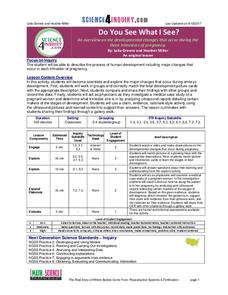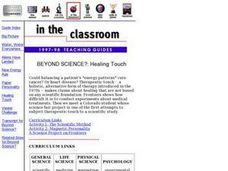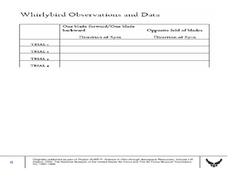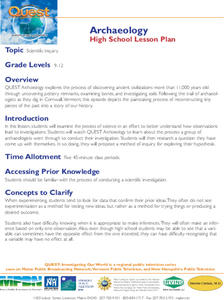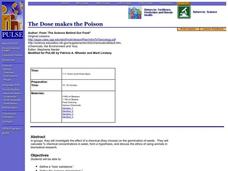Curated OER
Properties of Ionic and Covalent Compounds
Test six various reagents for their ability to conduct electricity. Cooperating chemists research whether each is ionic or covalent and discover the relationship between bonding and conductivity. This laboratory exercise would be an...
Science 4 Inquiry
Rocks Makin' Rocks: Rock Cycle Simulation
Scholars review prior knowledge before completing a hands-on simulation of the rock cycle. They write stories or songs summarizing their simulations to demonstrate mastery.
American Chemical Society
Why Does Water Dissolve Salt?
Individuals explore solubility by modeling how water dissolves salts. They then view a video and compare how well water and alcohol dissolve salts, relating their comparisons to the structure of each molecule.
Curated OER
Peanut Butter and Jelly: The Importance of Detailed Procedures
Students write a list of steps to be taken in making a peanut butter and jelly sandwich. They observe as the instructor literally follows each step. After realizing the importance of clear communication, students write a scientific...
Foundation for Water & Energy Education
How is Flowing Water an Energy Source? Activity B
Explore the world's water without leaving the classroom! In this second of three uncomplicated but wonderful activities, physical science learners feel the pressure of water. They discover that the deeper the water, the stronger the...
Curated OER
Dental Chemistry Analogy
After taking in background information on teeth, marble, eggshell, and fluoride, chemistry aces design an experiment. Their goal is to demonstrate whether or not fluoride has a similar effect on marble or eggshell as it does on tooth...
Curated OER
Work Hard and Work Smart: Designing for Athletes
Students design new insights into work tied into athletes. Students design a sports bag for athletes. Students investigate varied sports. They interview people involved in varied sports. Students engage in active problem solving as they...
Science 4 Inquiry
Do You See What I See?
In only nine months, a small group of cells grows into a fully developed baby. Pupils learn about the development of an embryo to a fetus to a baby. They identify each step of weekly development. Young scientists look at ultrasounds to...
Curated OER
Autism and Autism Spectrum Disorders: Disorders Extending Beyond the "Norm"
Learners develop an understanding of autism by engaging in an inquiry-based discussion. Pupils are exposed to the vast array of defining characteristics of autism spectrum disorders. They create posters about the developmental...
Curated OER
Beyond Science?: Healing Touch
Students apply the scientific method by building a "Proposal for Study." They label the Observation, Hypothesis, and Prediction columns. Students listen as the teacher introduces the alternative healing methods of therapeutic touch and...
Curated OER
Weather Observation Journal
Students record weather for a period of one month. In this weather lesson, students observe weather for one month on a large pictograph. Students record clouds, wind, temperature and any other weather conditions they observe. Students...
Curated OER
Science: Observing Fish Behavior
Young scholars identify and explain various fish behaviors through observation. Over several months, they watch one fish in the classroom aquarium and record its behaviors in notebooks. They visit a virtual aquarium Website to find...
Curated OER
Charles Darwin
Students research Charles Darwin and the process he used to develop his theory of evolution. They keep a journal about the skill of observation and make a newspaper of their learning.
Curated OER
Cloud in a bag
Students relate the states of matter and clouds. In this environment lesson, students create a chart of information they know about clouds. Students put an ice cube in a bag and tape to a window. Students watch for...
Curated OER
Summer Activities: The Wonders of Nature!
Students examine the world of nature. In this early childhood lesson plan, students develop observation skills as they bird-watch and make rainbows, experimentation skills as they explore seeds and carrots, prediction skills as they...
Curated OER
Living Organisms as Indicators of Pollutants in Fresh Water Ecosystems
Students observe the effects of pollution on living organisms. In this pollution lesson plan, students observe fresh water Hydra and look at their structures and movement. They place samples of pond and lake water on the Hydra and...
Curated OER
Principles of Flight: Gyrocopter and the Scientific Method
Students explore the concept of the scientific method. In this investigative lesson, students investigate which direction the blades will spin on a gyrocopter. Student will practice using the scientific method to complete the investigation.
Curated OER
Magnetism
First graders investigate magnetism. In this magnetism lesson, 1st graders classify objects as being magnetic or nonmagnetic. Students receive a pile of objects to test. Students test the items and give a rationale of why they think the...
Curated OER
Archaeology
Students examine how observations lead to investigations, and how archaeologists conduct their investigation.
Curated OER
Look At Those Leaves!
Students observe leaves and their attributes and group them accordingly. In this science observation lesson students gather leaves and use them to become more familiar with seasonal changes and the cycles of our environment.
Curated OER
Billions of Bubbles
Students conduct an experiment with bubbles. In this observation and comparison lesson, students read Bubbles, Bubbles, Everywhere and conduct an experiment where they test different kinds of liquids to see which is the best for a...
Curated OER
More Than Meets the Eye
Students use the Archimedes method to demonstrate scientific principles behind observations.
Curated OER
You're the Scientist
Students explore ways to assess the accuracy and reliability of data reported by Journey North observers.
Curated OER
The Dose makes the Poison
Young scholars investigate the effect of a chemical (they choose) on the germination of seeds. They calculate % chemical concentrations in water, form a hypothesis, and discuss the ethics of using animals in biomedical research.







